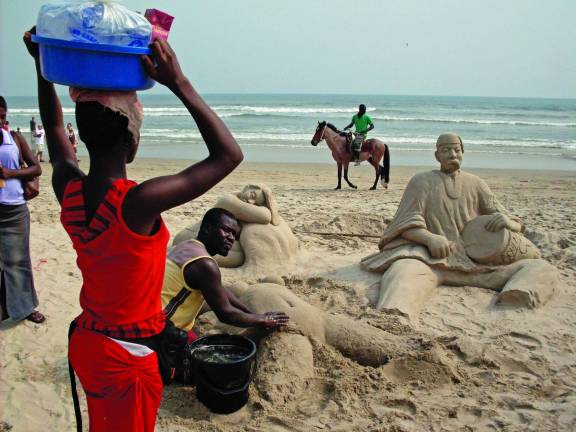Sculpted beach bods

Yes, we’d known it would be hot. Still, it was a shock. Had it gotten worse? No, I think the difference was that the last time we lived in this neck of the continent, we were in thirty-year-old bodies. BIG difference!
After working all week, on weekends it was too hot to do much exploring of the sidewalk-less city. At first, we felt a bit sheepish, especially me. We weren’t the kind of travelers who went to the beach every weekend. We traveled; we visited villages; we learned about their culture. Not this time: We were H-O-T. We went to the beach.
We’d find a taxi mid-morning and travel along a four-lane road to Labadi Beach. The first treat was driving past the shops selling whimsically carved and decorated coffins – a Ghanian tradition since the 1950s. Think Pepsi bottles, race cars, fish, cell phones, all carved and brightly painted.
Once at the beach, we settled into the area outside the restaurant, shaded by a generous awning. The restaurant guys greeted us as we arrived, starting us off with Geoffrey’s ice-cold beer and my ice-cold Coke (no ice cubes, of course). The kaleidoscope of activity delighted us. Africans, Westerners, Arabs – even women in black headscarves and veils – old, young, and everything in between. Child acrobats with exaggerated smiles jumped, ran, tumbled, and made human pyramids. Horseback riders sold rides, meandering pedicurists offered the possibility of pretty feet.
We ate; we lazed; we people-watched; we enjoyed whatever breeze we could catch. We swam in the narrow channel where swimming was permitted. It wasn’t cold, but cool water filled the bill.
To us, the highlight of Labadi Beach was Bob, the Togolese sculptor. We started looking forward to seeing his creations days in advance. Picture a seated African elder in a flowing robe holding a cylindrical drum under his arm. A couple stretched out lazily, she with her hand cradling his head, he with one hand coyly flirting with her bikini bottom. A couple holding children so emaciated their ribs poked from their chests. An elephant with elaborately wrinkled skin crouching on his forelegs.
All from sand.
Some might call them “sand sculptures,” but, to me, that label evokes images of kids’ sand castles, made with pail and shovel and maybe some shells stuck in the top. Wrong image. They’re sculptures, pure and simple, albeit transitory ones. Some were people, others animals, others architectural. All were representational, sensuous, and beautiful. Sand and water, rudimentary tools, talent and creativity in abundance. I’d never seen anything like them, and still haven’t.
Bob always set up “shop” in the same place. He was always there by the time we arrived and, after the first few times, waved when he noticed us. Short and stocky, he concentrated intensely while he worked. He’d repeatedly walk around his creation for different views, and he usually had sand scattered all over his shorts and tee shirt. He had two pails: one for water and one for donations. He was busy, talented, and friendly.
We settled into our weekday and weekend routines; they suited us perfectly. We didn’t feel the need to “do” Accra or Ghana thoroughly, or to squeeze everything in. We had nothing to prove in terms of how adventurous we could be. We could just find a life and live it.
Excerpted from Carole Howard’s Tales of a Silver-Haired Volunteer: Going Far and Giving Back (2016). Howard lives in Warwick.